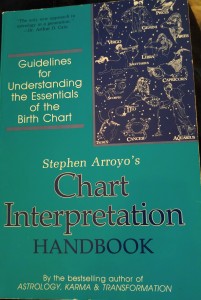Occasionally, I get asked this question (from my friends, clients or students):
“How can I learn more about astrology? What books or resources do you recommend?”
And so, I’m writing this blog to answer that question, both now and in the future. ?
First of all, lest I forget to mention the resources that I offer, personally: I am currently writing/editing my own (free!) upcoming e-book about the astrological signs. (Stay tuned!) And, I am available for astrological tutoring: to teach you the basics (signs/houses/aspects), or to help you dive into the advanced topics of chart interpretation, and transits/progressions. (Click to learn more, if interested.)
Now, without further ado:
My top 4 astrology book recommendations (for relative beginners):
#1: “All Around the Zodiac” by Bil Tierney
This was probably my favorite (if least technical) book that I read, and re-read, when I was first familiarizing myself with astrology. Tierney really breaks things down, and gives in-depth examples/descriptions, so that you can understand the style and motivation of each of the signs more clearly. And then, in the second half of the book, he explains how each of the signs relate to each other, organized by their angular relationship (whether they square, oppose, trine, etc.). This is a great way to go really in-depth into the signs/elements AND to begin to understand aspects. Start by looking up each of your planetary signs (e.g., Sun in Taurus, Moon in Pisces, etc.) and how they relate to each other (e.g., Taurus/Pisces listed under signs that sextile). That way, you can understand from the inside out. Tierney also gives celebrity examples for different sign/planetary combinations, so that’s a fun way to learn too.
#2. “The Inner Sky” by Steven Forrest
 Here’s a classic, from one of the most revered living astrologers. Steven gives a wonderful introduction to interpreting the astrological natal chart: how you might orient yourself towards it, then “decode” the different puzzle pieces (signs, planets, houses, aspects) and finally begin to synthesize the chart as a relatable, coherent whole. Steven is a wonderful storyteller, equally wise and pithy, and he manages to explain a pretty technical/complex topic in a way that seems both organic and systematic.
Here’s a classic, from one of the most revered living astrologers. Steven gives a wonderful introduction to interpreting the astrological natal chart: how you might orient yourself towards it, then “decode” the different puzzle pieces (signs, planets, houses, aspects) and finally begin to synthesize the chart as a relatable, coherent whole. Steven is a wonderful storyteller, equally wise and pithy, and he manages to explain a pretty technical/complex topic in a way that seems both organic and systematic.
3. “Chart Interpretation Handbook” by Stephen Arroyo
This book, and Steven Forrest’s book (above) were the reference texts for my own beginning astrology class (taught by Benjamin Bernstein). I now own multiple books by both authors, and they are well-worn and loved! In my opinion, Stephen Arroyo’s understanding of the different elements (fire, earth, air, water) is rivaled by no one. In this book, he gives spot-on explanations and keywords for each planet (Mercury, Jupiter, etc.) in each of the elements AND signs. This is wonderfully helpful in terms of understanding how each planet functions, how its expression varies by sign/element, and what it needs to function optimally. This, to me, is the highlight of the book. However, he also explains planetary interchanges (aspects)–for example, Sun/Mercury or Moon/Saturn–and how one might begin to approach synthesizing the chart as a whole. A valuable reference, on the whole, which I refer to even now.
4. “Astrology: A Cosmic Science” by Isabel M. Hickey
 Here’s another classic. (I even happened across it in the library, a few days back.) My own personal copy is greatly used, with highlights and pen notes throughout. Isabel starts at the beginning, by explaining each of the signs, in depth, plus the rulerships of each sign. (For example, Taurus is ruled by Venus, Aquarius is jointly ruled by Saturn and Uranus, etc.) She introduces the various astrological symbols, and elaborates on how each of the houses and planets function . Finally, she puts the different ingredients together–detailing how each planet functions in each of the different signs/houses, plus the signs where each is considered strong/weak.
Here’s another classic. (I even happened across it in the library, a few days back.) My own personal copy is greatly used, with highlights and pen notes throughout. Isabel starts at the beginning, by explaining each of the signs, in depth, plus the rulerships of each sign. (For example, Taurus is ruled by Venus, Aquarius is jointly ruled by Saturn and Uranus, etc.) She introduces the various astrological symbols, and elaborates on how each of the houses and planets function . Finally, she puts the different ingredients together–detailing how each planet functions in each of the different signs/houses, plus the signs where each is considered strong/weak.
Perhaps most valuably (and in greatest detail), Isabel then explains the wheel of the chart, with signs and houses, and goes very in depth into treating each rising sign (explaining, for example, how Aries rising has Taurus on the 2nd house cusp, and Gemini on the 3rd house cusp, etc., and what that means). Finally, at the end, she delves into interplanetary aspects and explains the implications of soft vs. hard aspects between the planets.
Although Isabel can be quite frank in discussing the potential downfalls of each planet & chart, and even though her language can be pretty dense (not very conversational), this is still the most comprehensive and essential astrology book that I own, for explaining ALL of the basics, in depth.
I hope you find my “top four astrology books for beginners” to be helpful in your astrological education. I will update this post soon to include some other essential/helpful non-book resources.
To sign up for my astrology newsletter, and to be among the first to receive a complimentary copy of my upcoming e-book on the twelve signs, click here.




